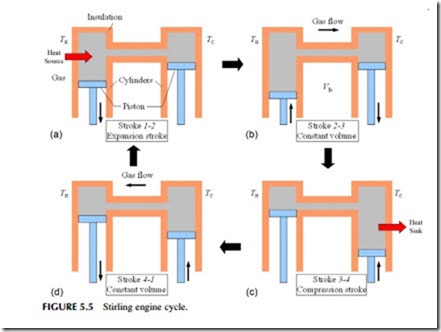STIRLING ENGINES
Whereas fuel combustion takes place within the cylinders of an internal combustion engine, the heat energy used to drive a Stirling engine is applied outside the cylinders, which are completely sealed. The engine was designed by a Scottish Presbyterian minister, Robert Stirling, who received his first patent in 1816.
The original Stirling engines used air within the cylinders and were called air engines but modern Stirling engines usually employ helium or hydrogen. Both gases are capable of absorbing a large quantity of heat rapidly, a key advantage for an external combustion engine. The gas within the closed cycle system will be pressurized to up to 20 MPa, roughly 200 times atmospheric pressure.
The simplest form of Stirling engine consists of two cylinders, each sealed with a piston but with the sealed end of each cylinder linked so that the working fluid, which is sealed within the two cylinders, can move from one to the other during the cycle (Figure 5.5). The heat source that provides the energy to drive the cycle is applied to one cylinder while a cold sink, usually ambient air, is applied to the second. The two cylinders are linked, externally, too, by a system of levers that ensures their movements are synchronized. There will usually be a
flywheel attached to the system to store energy from the power stroke, one of four in the cycle, in the form of angular momentum to drive all four stages.
In the first part of the cycle, the power stroke for the working fluid is contained in the hot cylinder and the cold cylinder piston is at the top of its cylinder, which is empty. The heat that is continuously applied to the hot cylinder causes the working fluid to heat up and increase in pressure and expand, forcing the piston to move toward the bottom of the cylinder. During this part of the cycle the cold cylinder piston remains stationary. The expansion of the hot gas pro- vides the power that drives the engine through its whole cycle.
In the second stage, the cold cylinder piston starts to move toward the bot- tom of its cylinder while at the same time the hot cylinder piston moves to the top of its cylinder, causing the working gas to move, essentially at constant pressure, from one cylinder to the other. However, as the gas is drawn into the cold cylinder it becomes cooled and the pressure falls.
In the third stage of the cycle the cold cylinder piston starts to move toward the top of its cylinder again, compressing the cold gas and generating some heat in the process, which is removed by the cold sink. During this stage the hot cylinder piston remains stationary.
The final stage, another essentially constant pressure stage, involves the cold cylinder moving to the top of its cylinder, forcing all the working fluid into the hot cylinder, while the piston in the hot cylinder starts to move down to accom- modate the cold working fluid. As this begins to become heated by the hot source, the cycle starts again. In essence, the full cycle involves the expansion and then the contraction of the working fluid.
Actual Stirling engines are generally more complex than this. Some replace one cylinder by a device called a displacer, and the working fluid often passes through a recuperator between the hot and cold cylinders so that energy other- wise lost can be captured and reused. This allows the cycle to approach the theoretical Carnot cycle efficiency for a heat engine, and high efficiency is one of the great attractions of the Stirling engine.
The other great advantage of the Stirling engine is that the heat energy is applied externally. Thus the energy can, in theory, be derived from any heat source. Stirling engines have been used to exploit solar energy and for biomass applications. However, their use is not widespread. Typical engine sizes in use and development range from 1 kW to 150 kW. In solar thermal applications a Stirling engine could theoretically achieve close to 40% energy conversion efficiency. The best so far recorded is just over 31%, which is still high for solar conversion.
